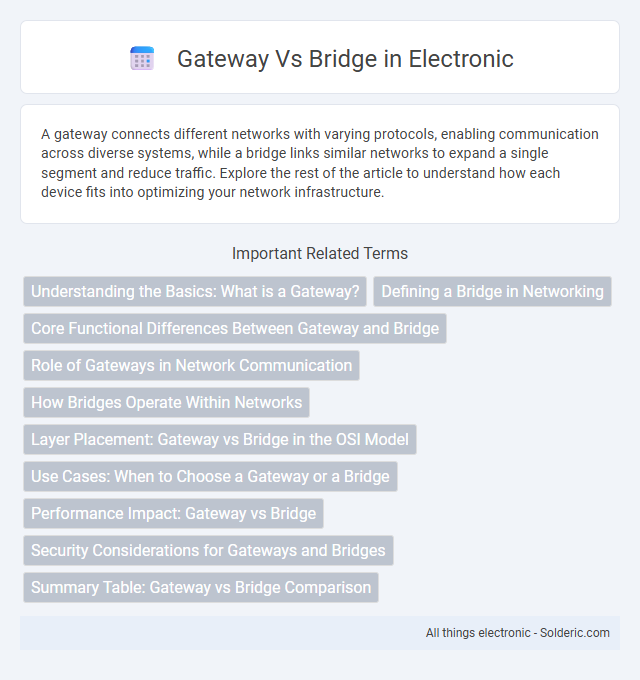A gateway connects different networks with varying protocols, enabling communication across diverse systems, while a bridge links similar networks to expand a single segment and reduce traffic. Explore the rest of the article to understand how each device fits into optimizing your network infrastructure.
Comparison Table
| Feature | Gateway | Bridge |
|---|---|---|
| Function | Connects different networks with different protocols | Connects similar networks to extend network segments |
| Layer | Operates at Network Layer (Layer 3) or higher | Operates at Data Link Layer (Layer 2) |
| Protocol Handling | Translates protocols between networks | Does not translate protocols; forwards frames |
| Use Case | Connects networks with incompatible protocols (e.g., IP to IPX) | Extends LAN by connecting Ethernet segments |
| Complexity | More complex due to protocol conversion | Less complex; simple forwarding |
| Example | VoIP gateway, network gateway | Switches, simple bridges |
Understanding the Basics: What is a Gateway?
A gateway is a network device that connects two different networks, often employing different protocols, to facilitate seamless communication and data transfer. It operates at multiple layers of the OSI model, translating data between various network architectures, such as between a local network and the internet. Understanding your gateway's role is essential for optimizing network connectivity and ensuring efficient data routing across diverse systems.
Defining a Bridge in Networking
A bridge in networking is a device that connects and filters traffic between two or more network segments at the data link layer (Layer 2) to reduce collision domains and improve overall network efficiency. It uses MAC addresses to forward data packets only to the segment where the destination device resides, minimizing unnecessary traffic. Your network's performance can be enhanced by using a bridge to segment traffic and reduce congestion without the need for complex routing.
Core Functional Differences Between Gateway and Bridge
Gateways operate at multiple OSI layers and perform protocol conversions, enabling communication between diverse networks with different protocols. Bridges function primarily at the data link layer, filtering and forwarding traffic between segments of the same network protocol to reduce collisions and improve traffic flow. The core functional difference lies in gateways enabling inter-network communication across varying protocols, while bridges facilitate intra-network segmentation without protocol translation.
Role of Gateways in Network Communication
Gateways function as critical nodes in network communication by translating data between different protocols, enabling seamless interaction between diverse systems, such as connecting an IoT device network to the internet. Unlike bridges, which operate at the data link layer to connect similar networks, gateways work at multiple layers, including the network and application layers, to facilitate protocol conversion and data routing. Their role is essential for interoperability in complex network architectures, ensuring efficient communication across heterogeneous environments.
How Bridges Operate Within Networks
Bridges operate within networks by connecting multiple LAN segments at the data link layer (Layer 2), filtering traffic based on MAC addresses to reduce collisions and improve efficiency. They learn and store MAC address tables to forward data frames only to the appropriate segment, minimizing unnecessary traffic. Bridges enhance network performance by segmenting large networks into smaller, manageable collision domains while maintaining transparency to higher-level protocols.
Layer Placement: Gateway vs Bridge in the OSI Model
A bridge operates at the Data Link layer (Layer 2) of the OSI model, connecting and filtering traffic between two LAN segments based on MAC addresses to reduce collisions and improve network efficiency. In contrast, a gateway functions at higher layers, often the Network (Layer 3) or Transport layer (Layer 4), performing protocol translation, data format conversion, and facilitating communication between different network architectures or protocols. Understanding your network's layer requirements helps determine whether a bridge or gateway is appropriate for seamless data transmission.
Use Cases: When to Choose a Gateway or a Bridge
Gateways are ideal for integrating different network protocols and managing data transformations in complex IoT environments where devices use multiple communication standards. Bridges are best suited for extending or segmenting networks within the same protocol, such as connecting two Ethernet segments to reduce traffic or improve performance. Choose a gateway for protocol translation and advanced routing between heterogeneous networks, while a bridge is preferred for simple network extension or traffic isolation within homogeneous networks.
Performance Impact: Gateway vs Bridge
Gateways typically introduce higher latency and processing overhead compared to bridges due to their role in protocol translation and complex traffic management. Bridges operate at the data link layer and forward traffic based on MAC addresses, resulting in minimal performance impact and faster data transfer within the same network segment. Your choice between a gateway and a bridge should consider the balance between necessary network functionality and the acceptable impact on overall network performance.
Security Considerations for Gateways and Bridges
Gateways provide enhanced security by performing protocol translation and deep packet inspection, which helps to enforce strict access controls and prevent unauthorized communication between different networks. Bridges operate at the data link layer, forwarding traffic based on MAC addresses without modifying packet content, offering limited security features and increased vulnerability to network-layer attacks. Proper security management in gateways includes robust authentication, encryption, and firewall integration, while bridges require supplementary network segmentation and monitoring to mitigate potential risks.
Summary Table: Gateway vs Bridge Comparison
Gateways operate at multiple OSI layers, enabling protocol translation and data format conversion, while bridges function primarily at the data link layer to connect and filter traffic between network segments. Gateways support diverse network architectures and complex routing, whereas bridges improve network performance by reducing collision domains within similar protocols. The summary table highlights gateways for inter-network communication and protocol interoperability, contrasting with bridges for localized traffic management and network segmentation.
Gateway vs Bridge Infographic

 solderic.com
solderic.com